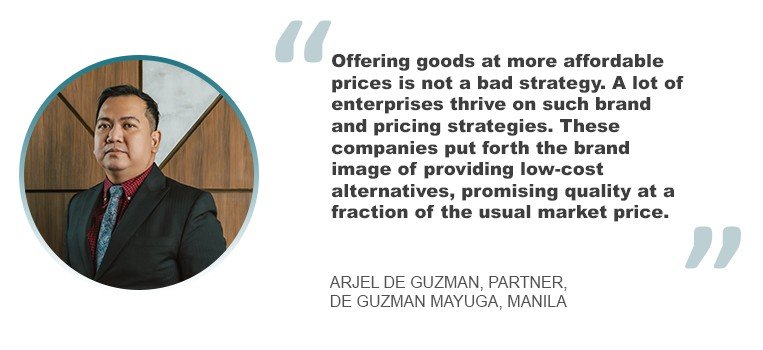Companies like Apple, Hermès, Hennessy, Rolex, Gucci, Louis Vuitton and other upscale luxury brands sell their products at steep price tags. They do this for a reason.
It’s called premium pricing, a strategy where business enterprises set their prices higher than those of their competitors. They use premium pricing to reinforce their brand image as providers of high-end, technologically advanced and highly desirable products. “Such brands can afford this because they have a strong brand identity and valuable brand equity in such a manner that they have managed to impress upon their target consumers that their brands exude luxury and exclusivity,” explained Arjel de Guzman, a partner at de Guzman Mayuga in Manila.
And then, there are those brands offering goods at more affordable prices, such as IKEA and Walmart. “This is not a bad strategy,” said de Guzman. “A lot of enterprises thrive on such brand and pricing strategies. These companies put forth the brand image of providing low-cost alternatives, promising quality at a fraction of the usual market price.”
Not only do their pricing strategies help build and strengthen their brand image, but they also help safeguard and enhance the value of their IP assets, such as trademarks, patents and copyrights.
Intellectual property rights help build a perception of product quality and authenticity in the minds of consumers, including the most discerning ones. “Premium pricing, for instance, can signal exclusivity and reinforce the IP’s distinctiveness in the market, discouraging imitation and enhancing brand equity,” said Risti Wulansari, a partner at K&K Advocates in Jakarta. As such, companies whose products and services are viewed as premium quality and authentic, especially if these businesses are reputable, are in a position to command higher prices. If a brand known for premium pricing suddenly lowers its prices significantly, consumers will likely question the quality of their products.
“Pricing is essentially linked to how a brand is perceived and positioned in the market. It shapes consumer expectations and differentiates the brand from competitors,” said Wulansari.
Such is the overlap of IP, branding and pricing. Identifying the right prices for your goods to best leverage brand equity and IP is a key element.
What’s your pricing strategy for branding?
There is no such thing as “one size fits all” as far as pricing strategies are concerned.
First of all, it isn’t just about deciding whether to increase or decrease the prices to drive profits. Establishing a pricing strategy is more complex than that.
“The appropriate pricing strategy for an enterprise to reinforce its brand image, add value to its IP and improve or maintain its market position depends on various factors, including the company’s goals, target market and the nature of its products or services,” explained George Chan, a partner at Simmons & Simmons in Beijing and head of the Simmons & Simmons (Beijing) Intellectual Property Agency.
“Consumers fixate on price,” stressed David Haskel, a partner at Abacus IP in Phnom Penh. “If your pricing strategy doesn’t align with the market and your business model, you will fail. For a lot of goods, consumers make a split-second decision on whether your price fits what they value and are willing to pay. Price too high and you’ll have no buyers,” he said, “too low and you’ll never make enough revenue.”
Chan shared the following pricing strategies:
- Value-Based Pricing. Instead of setting prices based on production costs, determine prices in accordance with the market’s perceived value of the product or service. “It can help reinforce a brand’s image of providing high-quality products or services and can also enhance the value of the company’s IP,” explained Chan.
- Premium Pricing. Consider premium pricing if your company has a strong brand image and unique IP. This involves setting prices higher than those of your competitors. Premium pricing will reflect your product’s or service’s innovation, superior quality and exclusivity.
- Penetration Pricing. This may be effective for companies introducing a new product or service and aiming to grab a slice of the market quickly. Penetration pricing means setting a lower initial price to attract customers. “Once market share is gained,” said Chan, “prices can be gradually increased.”
- Skimming Pricing. This pricing strategy is advisable to business enterprises touting a unique product or service and there’s little competition or none at all in the market, often due to their strong IP. Chan advised: “Set high prices initially – skimming the top of the market – and then, lower them over time as competition increases.”
- Bundle Pricing. Sell multiple products or services together, as in a bundle, at a lower price than if these are sold separately. Bundle pricing encourages larger purchases and increases customer perception of value, thereby improving the company’s market position.
Franck Fougere, managing partner at Ananda IP in Bangkok, stressed that no customer likes to find out they have been cheated. Hence, it is important to have a clear and honest pricing tactic, or transparent pricing, for brand integrity and long-term customer relationships.
Equally important is consistent pricing. This helps build reliability and customer trust by ensuring that the company values their buying capability – a huge step forward in terms of branding. “Fluctuations in pricing are not recommended as they confuse customers and damage brand loyalty. One famous example here in Thailand is the brand Lactase, which used as a cornerstone of their branding strategy the slogan ‘Lactasoy five baht’ which for many years was the actual price of their drink,” Fougere pointed out.
“Lower prices might imply affordability and accessibility, but could risk a perception of lower quality,” added Chan. “Therefore, striking a balance between pricing and branding is essential, with the price reflecting the brand’s value proposition and the brand meeting the expectations set by its price point.”
Pricing tactics for startups, small and medium-sized enterprises (SMEs)
“For startups and SMEs, the more important question is identifying the company’s short-term as well as its long-term objectives,” said de Guzman. “We have to bear in mind that SMEs are in a peculiar situation, unlike big and multinational companies that can easily identify and perhaps dictate a minimum advertised pricing. However, for startups and SMEs, there could be an interplay in the company’s immediate objective like penetrating the market at an early stage, making quick or early profit, or even the mere goal of staying financially afloat during the early stages of the business. Such goals should be harmonized with the company’s long-term goals like attaining a strong brand identity, creating market barriers through strategic pricing or adopting a dynamic pricing strategy.”
The following are our interviewees’ tips for SMEs, including how startups can go about determining their pricing tactics:
- Do comprehensive market research. Conduct thorough market research to understand your target audience. Research will tell you their values, purchasing behaviours and willingness to pay. Research your competitors as well. Identify them and analyze their own pricing strategies.
- Set clear pricing objectives. These should be aligned with your business goals.
- Define your value proposition. Clearly articulate your product’s or service’s unique value. Bear in mind that the prices of your goods should reflect their benefits and value. “If your offering provides significant advantages over competitors, you can justify higher prices,” said Wulansari.
- Do not undersell. “Unless you have a competitive advantage on your cost of production and want to be the low-cost leader, you’re really harming your brand perception by underpricing,” warned Haskell. “You may see good acquisition results, but those buyers will not stick around when you start raising your prices. If you can’t start at a sustainable price, you haven’t validated your value proposition and need to go back to square one.”
- Start with penetration pricing. This is recommended for startups since this pricing strategy can help attract customers fast. Set lower prices initially to build brand awareness and gain market share. Once you’ve built a solid customer base, gradually increase your prices to reflect the true value of your products or services.
- Consider value-based pricing. When deciding your product price, don’t base it solely on production costs. Instead, focus on the value that consumers will derive from your products or services. How much are they willing to pay for these unique benefits? This approach can help you set prices that maximize profitability while reinforcing your brand’s value.
- Leverage psychological pricing. Customer perception is key. Hence, using pricing techniques that influence customer perception may be effective. For example, pricing a product at $19.99 instead of $20, called charm pricing, can make the price seem more attractive. Another way of shaping customer perception is bundling products or services. This can create a perception of added value, thus, influencing consumers to purchase these bundle of items.
- Offer tiered pricing. Multiple pricing options catering to different customer segments are also useful to startups and SMEs. “For instance, offer a basic version at a lower price and a premium version with additional features at a higher price. This allows customers to choose the option that best fits their needs and budget, increasing overall sales,” explained Wulansari.
- Experiment and adjust. “Pricing is not a one-time decision,” reminded Wulansari. “Be prepared to experiment with different pricing strategies and adjust based on market feedback. Monitor sales, customer responses and competitive actions. Use this data to refine your pricing strategy and optimize it for maximum impact.”
At the same time, monitor your costs and regularly review your cost structure. “It is crucial to ensure prices cover costs and yield a reasonable profit margin,” said Chan, “particularly for businesses with tighter budgets.” Adjust the prices as needed to maintain profitability while remaining competitive.
- Focus on building brand loyalty. Offer discounts or loyalty programs so customers will keep on purchasing. Not only will they continue buying from you, they will also gladly recommend your brand to their families and friends. This will help you solidify your brand image and grow your market presence. Customer trust and loyalty are crucial for startups and SMEs.
- Communicate the value customers can receive for the price. “This can strengthen the brand and support the chosen pricing strategy,” explained Chan. Creating a strong emotional connection with your customers is important.
- Stay compliant with regulations. Alwayscomply with local regulations and industry standards for pricing. Do not deceive your customers. Good practices always build trust and credibility with customers and stakeholders.
- Seek professional advice. Consult pricing experts or business advisors who can guide you based on industry and market conditions and help you determine the best prices.
“Not everything is about price,” Fougere emphasized. “If you are in a niche market, say luxury jewelry goods, clearly the price is less important than if you try to penetrate a highly competitive market, like selling rice.”
Reiterating that branding and pricing are interconnected, Fougere reminded that a business enterprise without a proper brand strategy will not be able to raise its brand equity and might be limited in the future if it plans to increase its prices.












